An overview of floor waterproofing methods
All structural elements of a house or apartment, including floors, need reliable protection against high humidity. If the apartment is located above a damp basement, moisture gradually destroys the concrete floors. In the logs and boards of the wooden floor from increased humidity, a fungus develops and decay begins. Even in a high-rise apartment on the middle floor, when moisture penetrates through cracks at the joints of the floor and walls, parquet, laminate or carpet lose their appearance and may become worthless. To these objective “accidents” are added subjective leaks due to one’s own carelessness and “floods” from neighbors, primarily flooding the floors. High-quality waterproofing of the floor is the most reliable way not to encounter the listed troubles and the annoying smell of dampness in your home.
Content
- Waterproofing: types and classification
- Roll and film materials
- Mastics for floor waterproofing
- Liquid water repellent materials
- Powder materials for waterproofing
Waterproofing: types and classification
Depending on the purpose and operating conditions of the room, various materials are used for waterproofing the floor, which by creating a dense waterproof and water-repellent layer on the surface or penetrating inside, protect it from destruction and decay.
By scope of application, all types of waterproofing are divided into two large groups:
- for outdoor work;
- for internal work.
According to the main water-repellent component in the composition, waterproofing is:
- bituminous;
- based on mineral components;
- polymer;
- bitumen-polymer.
According to the method of application on the surface, the following main types of waterproofing materials are distinguished:
- rolled;
- film;
- penetrating;
- membrane;
- painting;
- okleechnye;
- spreading;
- powder;
- plastering.
If the floor is waterproofed in an apartment or in a private house, they provide the best effect, and therefore the following materials are most popular.
Roll and film materials
The most familiar and popular representatives of this vast group of waterproofing agents in the past century are roofing felt, roofing material and glass-roofing material. They were used and continue to be used to isolate foundations, roofs and floors from moisture. They are cardboard or fiberglass, impregnated with a mixture of bitumen and basalt chips..
Modern rolled floor waterproofing is represented by polymer multilayer membranes, combining, as a rule, not only waterproofing, but also thermal insulation properties.
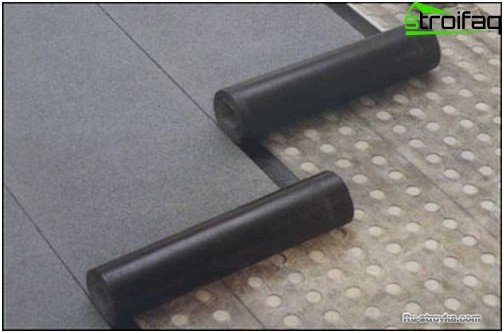
Self-adhesive roll waterproofing quickly installs, fastens to the base without any problems
Film waterproofing is a roll of polyethylene, polypropylene, polyvinyl chloride films that are most often used if waterproofing of a concrete floor is required before creating a dry or cement-sand screed.
Mastics for floor waterproofing
This is the second most popular group of waterproofing materials – plastic adhesives based on bitumen, liquid rubber, polymers, resins, plasticizers and other additives. In residential premises, mastic is used for waterproofing the floor to create a waterproof layer, as well as processing joints and seams in the bathroom, toilet, kitchen, sauna, pool. Waterproofing mastics are hot and cold type.
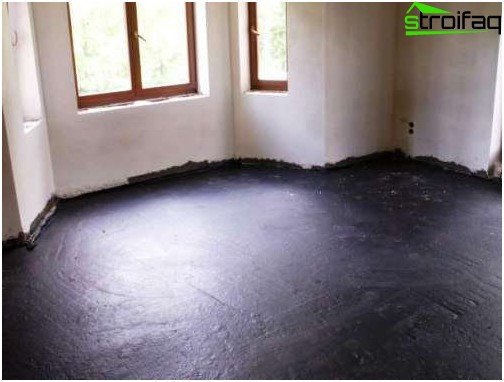
Mastic for waterproofing the floor forms a dense waterproof surface, fills all pores and cracks
Liquid water repellent materials
A wide group of waterproofing materials, which include primers, varnishes, paints, impregnations, injectable formulations for topical use, and many other liquid waterproof and water-repellent materials of varying degrees of viscosity. Such the latest liquid waterproofing of the floor, such as Penetron, is applied to the surface and, penetrating into the pores of the material, dry out in the form of a waterproof, but air-permeable crystal. Other flowing materials create a thin but strong water-repellent film on a wooden or concrete floor surface..
Powder materials for waterproofing
Presented on the construction market with a huge assortment of dry mixes based on different proportions of cement, glue, binders and plasticizers. Just before applying to the surface in a dry mixture, you just need to add water according to the instructions and waterproofing the floor with your own hands will not be a problem even for a beginner in construction. Powder mixtures are used to create concrete screeds, a waterproof layer on the floor and walls of pools and basements.
Methods of waterproofing the floor
There are several ways to waterproof a floor, but they all obey one general rule of continuity..
It is important to remember:
At the junction of the floor with walls or other structures protruding above the surface, the waterproofing layer must, without interruption, rise to a height of at least 30 cm above the floor.
Application of liquid waterproofing
This method of waterproofing the floor surface, depending on the composition and consistency of the material, is of two types:
- cast waterproofing;
- impregnating waterproofing.
Cast waterproofing is the application of polymer or asphalt (bitumen) solutions to the floor surface, which, when solidified, form an even, waterproof film. Bituminous mastics or solutions are heated to a temperature of 120-140 ° C, poured onto a pre-cleaned floor and leveled with a wide spatula in an even layer.
The cast waterproofing method is used only for the treatment of rigid monolithic substrates before pouring a cement-sand screed. The waterproofing material is applied in several layers, which, if necessary, are reinforced with a metal mesh or fiberglass. As a result, the thickness of the waterproof film should be 5-15 cm.
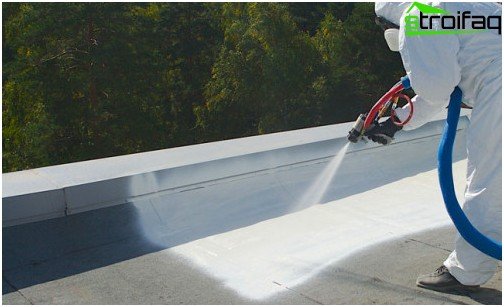
Application of liquid waterproofing material with a spray gun, it is possible to apply the composition with a brush
Impregnating liquid waterproofing the floor in an apartment consists in spraying with the help of special equipment or in applying liquid polymer impregnations and primers with an ordinary brush. These materials infiltrate the base of the floor to a certain depth, or freeze on its surface, forming a monolithic seamless waterproof membrane.
Painting and coating
Unlike cast, involving work with heated bituminous mastics, waterproofing and coating of the floor is performed when the base is treated with “cold” polymer and rubber-epoxy or “hot” bitumen-polymer mastics, as well as paints and varnishes. Depending on the viscosity of the composition, it is applied to the surface with a spatula, roll or a regular paint brush.
A common feature of all options for coating and painting waterproofing is to obtain a fairly thin, about 2-3 mm thick, waterproof layer on the floor surface, which is also an effective anti-corrosion and antifungal protection. True, the service life of this type of waterproofing does not exceed 5 years.
Use of pasting materials
As the name implies, this type of waterproofing involves the laying of rolled and sheet waterproof materials that are glued in layers on a previously cleaned and primed floor base. There are three ways to paste waterproofing:
- Simple flooring on any material or floor structure with a joint or independent method of fastening: under a cement or dry screed, under a plywood or other subfloor, etc..
- Fusing roll material onto the surface of the floor with a gas burner is a fire hazard method requiring strict observance of fire safety standards.
- Sticking roll waterproofing on the floor with special adhesives and mastics.
Many modern types of rolled film waterproofing are available with their own adhesive layers, which simplifies their installation. If mastics on a bitumen-polymer basis are used to glue the layers of roll waterproofing, they are selected so that their melting point is 20-25 ° higher than the highest air temperature typical of the room.
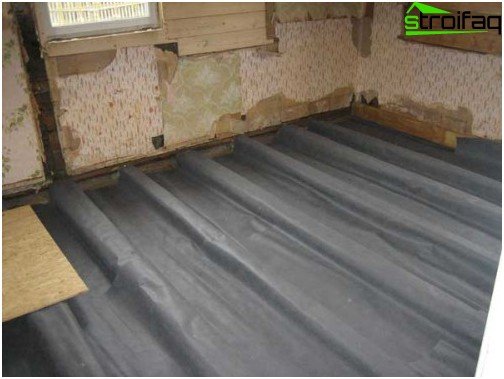
Nakleechnaya waterproofing of a wooden floor works well in a floor cake, with both dry and wet screed
All types of gluing waterproofing are very sensitive to shear and tensile loads, and therefore it is recommended to use it when protecting rigid structures made of brick, reinforced concrete or concrete from excessive moisture.
Stucco: ways to do it
Well-known, environmentally friendly, quite effective and easy-to-use method of waterproofing using a variety of dry mixes based on cement with the addition of astringent mineral and polymer additives. One of the main advantages of stucco waterproofing is that a plastic mortar based on cement fills well any irregularities, cracks and cracks in the base, and it can be applied in one or several layers with a spatula or brush on any surface: concrete, stone, wood, tile and even over paint.
As a kind of plaster, backfill waterproofing can also be considered, in which loose waterproofing materials pour out on the treated surface in an even layer and, absorbing moisture, form a durable waterproof layer.
Important!
It takes about 14 days to harden the plaster waterproofing and at this time it must not be allowed to dry out. During the first days after application, a fresh waterproofing layer is moistened from the spray bottle every three hours, and then twice a week.
Guide for Home Masters
When choosing the material and method of how to waterproof the floor, the individual characteristics of the operation of the room should be taken into account:
- increased humidity and the presence of stationary plumbing equipment in the bathroom, toilet or pool;
- the presence of a heating system “warm floor”;
- aggressive atmospheric effects on the balcony.
Waterproofing underfloor heating
In addition to protection against excessive humidity waterproofing warm floor should also provide reliable corrosion protection for the main working elements of the heating system – electric mats or pipe system.
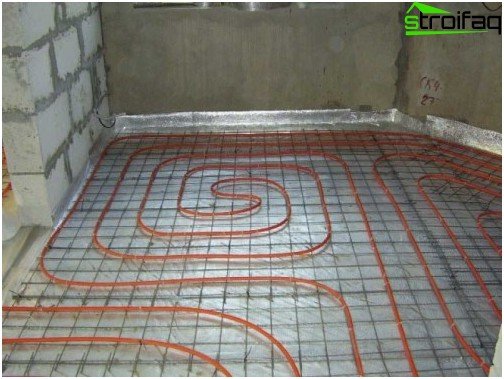
Waterproofing of “warm floors” not only creates a waterproof layer, but also protects elements from corrosion
Before pouring screeds waterproof the basement of the warm floor, using either mastics or rolled materials, treating the seams and overlaps of the insulating material on the walls with bituminous mastic. An alternative floor waterproofing device with a built-in heating system is a base coating waterproofing using traditional bitumen, bitumen-polymer or cement-polymer mastics. A cement-sand screed is poured onto the frozen waterproofing layer for laying the final floor covering..
Waterproofing the balcony floor
Unglazed balconies and open terraces are subject to sharp changes in temperature and humidity, scorching heat, frost, fog, rain and snowfalls, and therefore waterproofing the balcony floor is a necessary measure that will reliably protect the balcony slab and other supporting structures from destruction.
It is recommended to equip the floor in rooms with a stable high level of moisture, where water leaks from the water supply system are possible, with a waterproofing layer.
The process of arranging high-quality waterproofing of floors in any residential premises does not require special special skills, and the extremely simple laying technology of most modern materials makes this work a pleasant experience. The main condition for the durability and effectiveness of protecting the floor from high humidity is the right choice of material.






